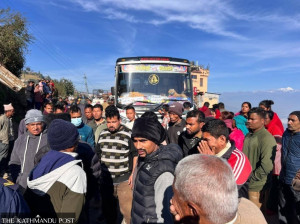Bagmati Province
Budget for target groups used unproductively in Province 3
Half of the budget allotted for women, children, and the elderly has been invested in campaigns and seminars.Subash Bidari
The budget allocated by Province 3 government targeting select groups of people failed to yield any result in two years. Half of the budget allotted for women, children, disabled and elderly in the fiscal years 2018-19 and 2019-20 has been invested in unproductive purposes, such as training, seminars, monitoring and campaigning.
In the last fiscal 2018-19, the Ministry of Social Development of Province 3 had allocated Rs 480 million under the headings of the target group. Of the total, about Rs 300million was invested in unproductive headings that are unlikely to bring any significant change to the lives of the target groups of people.
This fiscal year, the total budget has plunged to Rs 360million, the majority of which is slated for investment in headings such as industrial exhibits, report publishing, leadership development training, skill-based training and publishing and broadcasting of informative material.
Indira Ojha, chief of women’s development at the Ministry, said that the implementation of the programmes is lacking because of a shortage of officials. “Last year, the implementation was met with legal hassles, employee adjustment programmes, and lack of a detailed working procedure,” Ojha said. “In my own department, out of a total of five vacancies, only two are filled. We are sure to face the same hurdles this year again.”
While a few programmes such as skill-based training and leadership training look impactful, the ministry lacks a prudent mechanism to implement the programmes at the local levels, Ojha added.
According to her, additional programmes this year include rehabilitation of the disabled, campaign against child marriage, buildings for elderly and victims of gender discrimination and declared of child-friendly local levels.
Among the goals, the toughest one to meet is to make the province ‘child-marriage free’. The provincial government lacks statistics about the status of child marriage in at least 119 local units across 13 districts in the province. According to 2011 census, out of the total number of marriages in the province, 29 percent are child marriages.
“We don’t have statistics, so the current status of child marriage in the province can’t be ascertained,” Ojha said. “To achieve this goal, too, what we lack is a proper workforce.”




 9.12°C Kathmandu
9.12°C Kathmandu













